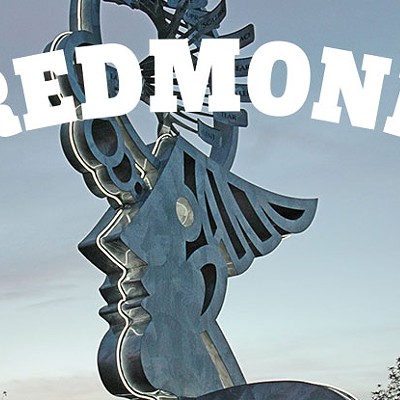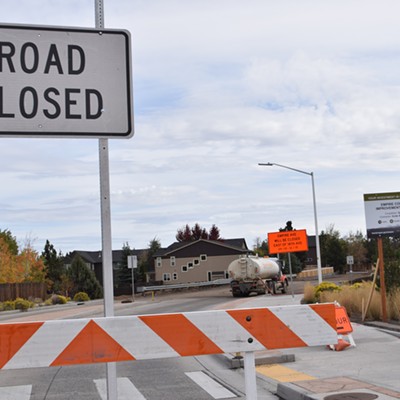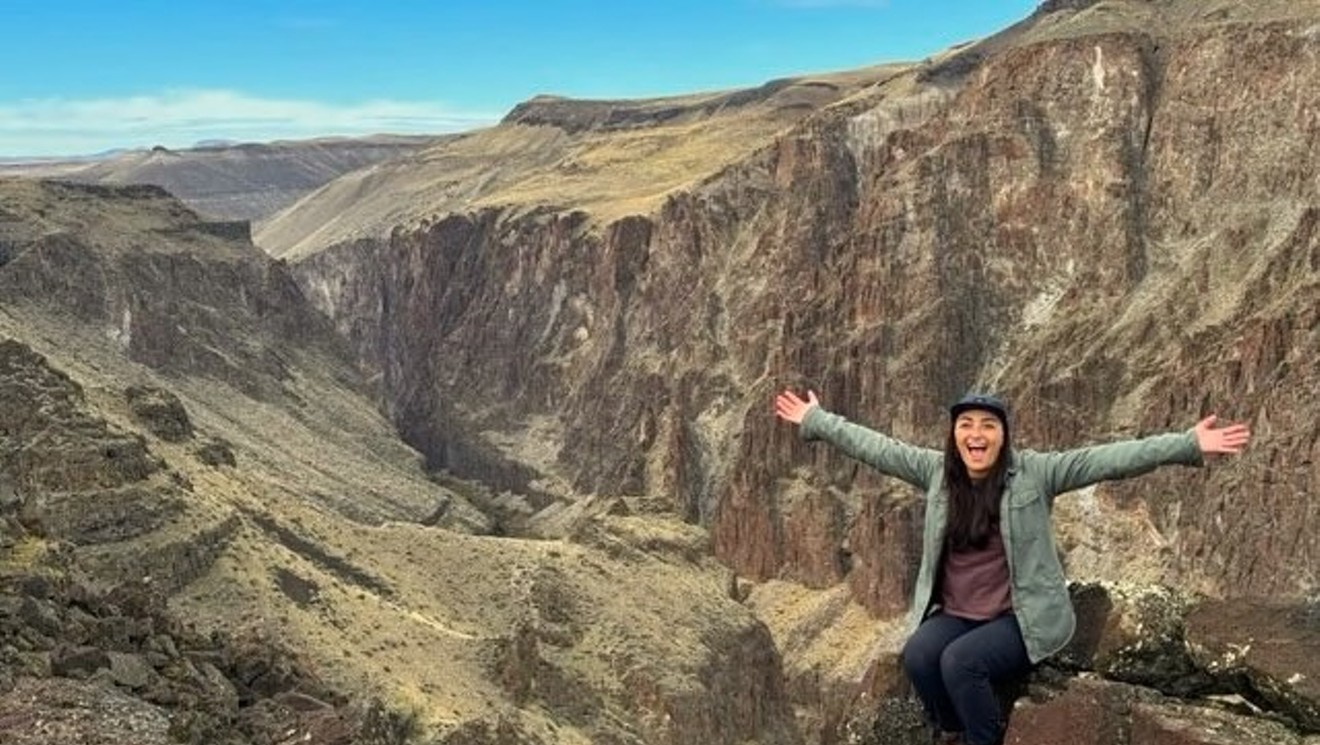Just past Worthy Brewing, on Bend's east side, the contrast between city and county is stark and sudden.
To the west, cookie-cutter housing complexes line the streets around big box stores and massive parking lots. To the east, deer carcasses decompose in the ditch on a recent Sunday evening, while rock chucks scurry around expansive fields surrounding modest farm houses. Between the two dramatically different spaces is the infamous urban growth boundary, the largely unmarked line beyond which Bend shall not build—and that contrast between urban and rural is just one reason why the decision over where, and how much, the urban growth boundary ought to shift to accommodate Bend's fast-growing population is being hotly debated.
By 2028, Bend's population is expected to swell to approximately 115,000 people—an increase of about 35,000, or roughly 40 percent, over today's numbers. And while some residents would like to scrawl "No Vacancy" under the Welcome to Bend sign, there's no turning people away. The retirees are coming. The students are coming. The ski bums are (still) coming.
Where will those additional residents live, work, and play—and how will they travel among these destinations?
With a rental vacancy rate of less than 1 percent, a plethora of low-paying service industry jobs, and trails showing their wear, there are no simple answers about how to accommodate growth while preserving the city's integrity. But these are some of the key questions the City of Bend's UGB remand process brings to the surface.
Houses, houses everywhere, but not a place to live
Since 1973, state land use law in Oregon has required cities to periodically revisit plans and expectations for future growth. The idea is to ensure there is an ample supply of land—and plan—for housing and jobs, while still preserving farmland and countryside from unchecked development.
In 2009, the City of Bend submitted its last UGB proposal, an idea at the time that advocated for adding some 8,000 acres to the City.
But the state said, "no," and sent the proposal back with some heavy red pen edits; namely, directing the City to make more efficient use of the land already within its boundaries, rather than simply expanding.
What does this mean for the average Bendite? Though the UGB remand process is rife with technical details, it is more than a simple planning document. Rather, it is both a literal and figurative blueprint for Bend's future, capturing the community's values and vision.
On a practical level, many believe that how—and where—the urban growth boundary is allowed to expand, and the types of efficiency measures enacted within the existing limits, will significantly impact the supply and cost of housing.
"The main thing at stake is housing affordability," says Councilor Victor Chudowsky. "The City's stalled UGB efforts contributed to the current housing crisis." He adds that the city is on track to complete the new UGB proposal—and submit it to the state—by next spring, a plan that would allow for the construction of more than 16,000 new housing units, including more apartments. Many of these will be within Bend's current boundary. "If we don't do this then," Chudowsky hastens, "people with lower and middle-range incomes will not be able to live in this city."
But, in spite of that assessment—both of the need for more affordable housing and the potential impact of the UGB expansion on the cost of land within the City—not everyone agrees exactly how where the UGB should flex to allow Bend to expand, or what housing should look like within the UGB. Some want single-family houses with generous lawns at the edge of the city, while others advocate for more urban options, such as apartments above shops near the downtown core.
Central Oregon LandWatch Executive Director Paul Dewey favors density over sprawl, and hopes the city will grow up, rather than out.
"Given Bend's proclivity toward explosive growth, change is coming fast and it will either be good or bad very soon," Dewey says. "'Smart growth' looks sustainable," he adds. "It is more urban—with at least three-story buildings and a large residential population near the city core—than suburban. It preserves the surrounding forests and other rural land. It allows more walking and biking and creates neighborhoods."
That density has worked for cities like Portland, which has dramatically developed its neighborhoods over the past decade, including massive projects to build multistory condos to accommodate that city's booming population. But, even some former supporters of maintaining the UGB to force that sort of growth—and corresponding preservation of the countryside—have begun to question whether it is the best way to manage Bend's particular set of pressures.
Former Bend mayor Bruce Abernathy, for example, was among a slate of candidates who ran on a slow-growth platform in 2000, but now he says he's walking a more centrist path.
"The UGB is designed to sort of control and manage growth [outside of its boundaries]," Abernathy says. "The flip side is you really can't control the rate of growth inside the UGB...that was the realization I had so I kind of backed away from that. It's important to manage the growth rather than control the rate of growth."
Abernathy notes that in 2005, when he and his fellow City Councilors were working on the last UGB proposal, Bend was sixth-fastest growing city in the country, as measured by the breakneck speed at which single-family housing permits were being issued. Moreover, a decade ago, the population and housing market surge led City Council to believe that the City would need a whole lot more land. So, in its last request to expand the UGB, it asked for about 8,000 additional acres.
"One strategy was to try to go bigger than we needed to go so we wouldn't get caught in this trap again where the demand is putting too much pressure on the available supply," Abernathy recalls.
This time around, the remand process is less manic, and has scaled back its request to about 2,000 additional acres, with a carefully crafted mix of housing types.
Big city, bright lights
It's easy to miss, but one of the most contentious aspects of the UGB conversation is an otherwise benign four-letter word: City.
Because Oregon land use law is structured to help preserve open spaces, it strongly encourages density. As Bend's population approaches the 100,000 mark, it will move further and further away from the small town it was just a decade or two ago.
And not everyone is happy about that.
"Parts of Bend will start to look more like a real city," Chudowsky says. "Some people will like this, particularly people who desire an urban environment or who don't like sprawl." He adds, "other people won't, because they moved here for the elbowroom they did not have in Seattle or California, or they desire the bucolic Bend of their youth."
But Chudowsky believes that not only can a balance be struck, but that it is not actually a trade-off, but potentially a win-win. "I'm pretty optimistic. This city has the potential to be a real jewel, even more than it is now."
No, it doesn't mean turning Bend into Portland, even though infill and housing density have both been major themes in the redrafting process of the UGB proposal to the state. Even so, it isn't likely Bendites will see four or five-story condos popping up on every corner. In fact, many parts of the city will see little-to-no change, but one neighborhood that has been targeted for a more urban approach to redevelopment is the so-called Central Area, just east of downtown; an area roughly bounded by Third Street on the east, around the tracks on the west, Revere on the north, and the railway underpass south of Franklin on the south.
COLW's Dewey says that blueprinting development for certain neighborhoods can help take pressure off others. "Mixed use development, multi-story buildings with a strong residential component, including affordable housing," he explains, "would allow population growth in Bend's center, allowing people the ability to walk and shop downtown and shop on Third Street without as much increase in traffic as would occur in a suburban pattern."
But, in order to accommodate this mix of growth and preservation, city leaders emphasize that Bend's "suburban" development code must be updated; currently, they say, it is failing to meet the needs of an increasingly urban city. Code changes—like reducing parking requirement, increasing density, and allowed mixed-use zoning—are likely on the horizon.
And, it is more than what Bend will look like—whether single-story homes with sprawling lawns, or sleek four-story condos. Many point out that how a space—and a city—is designed, overall affects its neighborhood character.
"One challenge of growth is that it becomes harder to conduct business based on knowing people," laments Deschutes County District Attorney John Hummel, who moved to Bend in 1996 for a job. "Thirty years of friendship and trust, followed by a handshake, is how many business and civic deals were struck in Bend. As new people arrive, start businesses, and become involved in service clubs and local government, we end up interacting professionally with people who are new to us. This is uncomfortable for many of us."
But with that growth also can come benefits. Andy High, who works for the Central Oregon Builders Association and serves on the Bend-La Pine School Board and the Affordable Housing Advisory Committee, says he anticipates an increase in economic opportunities.
"I see an increase in family wage jobs and a real increase in economic diversity," High says. "I believe we will continue to diversify the economy and not be so reliant on housing and tourism."
Fears of future growth
"I think we are at a key decision point that will shape Bend's future," says Mike Riley, executive director of The Environmental Center. "We need to look hard at meeting as much of the projected 'need' for housing and jobs within the existing UGB first and then move to expansion."
Aaron Broadbent, a 30-something Bend native, says he worries that growth will threaten the very qualities people are moving here to enjoy. "I feel like such a hypocritical crotchety old man even saying that, but I know I'm not the only one." He continues, "As Bend grows, that 'Central Oregon Lifestyle' and all those great outdoor opportunities that brought so many of us here just get less and less, well, good."
"I do not like the growth," he admits. "I do not welcome it. But I'm here. Sure I've been here awhile, but none of these places or things of nature are mine. So I'm just as much of the problem as anyone."



























